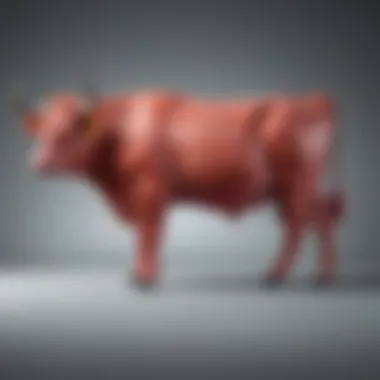Understanding Beef Emissions: Implications and Solutions


Intro
The rise of beef production and consumption is a significant factor in global emissions. Understanding these emissions is crucial, not just for environmentalists, but also for consumers, livestock farmers, and policy makers. The beef industry is a substantial contributor to greenhouse gases, primarily methane. This gas is released during digestion and manure management. The implications of beef emissions extend beyond climate change, affecting public health and resource sustainability.
In this article, we will explore the detailed mechanisms of methane production in cattle, assess the dietary influences that contribute to emissions, and review livestock management practices. Additionally, we will discuss emerging technologies designed to mitigate emissions, providing a comprehensive view of the topic. By synthesizing scientific research and practical applications, this narrative aims to shed light on the complexities surrounding beef emissions and promote informed dialogue among an engaged audience.
Preface to Beef Emissions
Beef emissions have emerged as a critical issue in discussions about climate change and sustainability. The importance of understanding these emissions stems from their significant contribution to global greenhouse gas emissions, particularly methane. Methane is a potent greenhouse gas, with a much greater warming potential than carbon dioxide over a short timeframe. As consumers and policymakers look for strategies to combat climate change, identifying the sources and implications of beef emissions is essential.
Defining Beef Emissions
Beef emissions refer to the greenhouse gases released during the production and consumption of beef. These emissions arise primarily from two sources: enteric fermentation in cattle and manure management. Enteric fermentation is a digestive process where cattle produce methane during the digestion of food. This methane is then expelled into the atmosphere. Additionally, the way manure is handled also contributes to emissions, particularly if it is stored in ways that promote anaerobic conditions, leading to methane generation.
Understanding the specific components of beef emissions is crucial for pinpointing effective mitigation strategies. Research indicates that emissions vary depending on factors such as cattle diet, production practices, and regional farming methods. By precisely defining these emissions, stakeholders can better develop targeted solutions to reduce their environmental impact.
Historical Context of Beef Production
The history of beef production dates back thousands of years and reflects the development of agriculture. Initially, cattle were domesticated for multiple purposes, including labor, milk, and meat. Over centuries, selective breeding and advanced farming techniques have intensified beef production. The industrialization of agriculture in the past century has further accelerated this trend, leading to increased herd sizes and meat output.
However, this surge in beef production has not been without consequences. The rapid expansion of cattle farming systems has resulted in significant environmental changes. Deforestation for pastureland, overgrazing, and land degradation are just a few issues associated with beef production. Consequently, historical production practices have paved the way for the current beef emissions scenarios, necessitating a detailed examination of their implications for both the environment and public health.
Understanding this historical context is vital as it illustrates the path to current emissions levels and highlights the need for innovative solutions to mitigate their impact. Recognizing the long-term effects of beef production helps inform better practices for the future, balancing agricultural demands with environmental realities.
The Science Behind Methane Emissions
Understanding the science behind methane emissions is crucial to grasping the multifaceted dynamics of beef production and its broader environmental implications. Methane is a potent greenhouse gas, contributing significantly to global warming. In cattle, methane emission primarily occurs through their digestive processes. This section will explore the various aspects involved in methane production and its impact on the environment.
Digestive Processes in Cattle
Cattle are ruminants, meaning they have complex stomachs designed to break down fibrous plant material. Their digestion involves multiple stages:
- Ingestion: Cattle consume grass and other forage, which is rich in cellulose.
- Rumen Fermentation: The ingested food moves into the rumen where a diverse population of microbes begins breaking it down. This process produces volatile fatty acids, which cattle use for energy.
- Methane Production: During fermentation, hydrogen gas is produced. Microbes convert excess hydrogen into methane, which is then expelled primarily through belching. This process demonstrates the intricate balance of digestion and microbial activity in cattle.
Understanding these processes highlights the importance of microbial health in reducing methane emissions. If we can alter the microbial population, we may influence the amount of methane produced.
Anaerobic Fermentation in Ruminants
Anaerobic fermentation is a critical process in the digestive system of ruminants. It occurs in environments devoid of oxygen, such as the rumen.
- Fermentative Microbes: The rumen is home to bacteria, protozoa, and fungi, all of which play harmonious roles in digestion. These microbes are instrumental in breaking down feeds into simpler compounds.
- End Products: The end-products of this fermentation include methane, carbon dioxide, and volatile fatty acids. While methane is the focus here due to its greenhouse gas properties, carbon dioxide also plays a significant role in overall emissions.
This process illustrates the complexity of feed utilization in cattle and the challenge of finding solutions to mitigate methane emissions. If alternative methods could be employed to redirect hydrogen away from methane production, it could benefit environmental outcomes.
Comparative Emission Data
Beef vs. Other Livestock
When comparing methane emissions from beef to other livestock such as sheep or pigs, beef stands out due to several factors. Beef cattle emit higher volumes of methane because:
- Larger Body Size: They generally have a larger digestive system, thus producing more methane per animal.
- Diet: Their diet, primarily forage, is high in fibrous content that requires extensive fermentation.
- Growth Rate: Beef cattle often take longer to reach market weight, which increases the duration of emissions.
These characteristics demonstrate why beef is often highlighted in discussions of livestock emissions. Consequently, addressing beef emissions could yield significant reductions in overall greenhouse gas output.
Beef vs. Plant-Based Diets
The methane emissions associated with beef significantly contrast with those of plant-based diets. Over recent years, plant-based diets have gained attention for their lower environmental impact. When assessing beef versus plant-based options, consider:


- Lower Emissions: Plant-based diets generally generate much lower methane emissions since they don't involve animal agriculture.
- Resource Efficiency: Growing plant crops for direct human consumption is usually more resource-efficient than raising cattle, which require substantial feed inputs.
- Land Use: Plant agriculture typically requires less land when compared to cattle farming, further enhancing sustainability.
This highlights a compelling aspect of reducing overall beef emissions: encouraging shifts towards plant-based diets can have far-reaching benefits for the environment and contribute to food security.
"Adopting plant-based diets can lead to significant reduction in overall methane emissions, playing a pivotal role in climate change mitigation."
In summary, the science underpinning methane emissions from beef cattle is intricate. Insights into the digestive processes, along with comparative emittance data, foster a deeper understanding of the environmental challenges posed by beef production and the feasibility of mitigation strategies.
Global Impact of Beef Emissions
The global impact of beef emissions is a critical area of concern due to its extensive reach into environmental and public health domains. Beef production contributes significantly to greenhouse gas emissions, primarily through methane. Understanding this impact is essential for forming effective mitigation strategies. The emissions from cattle production illustrate not only environmental challenges but also crucial health implications for populations worldwide.
Contribution to Global Warming
Greenhouse Gas Emission Statistics
Greenhouse gas emission statistics reveal alarming data regarding the contributions of beef cattle. The livestock sector, which includes beef, is estimated to account for 14.5% of all human-induced greenhouse gas emissions. Among these, methane is one of the more potent gases.
Methane's global warming potential is over 25 times greater than carbon dioxide over a 100-year period. This statistic underscores the urgency of addressing beef emissions. By evaluating greenhouse gas statistics, the agricultural industry can work towards targeted solutions. It provides a clear metric for policymakers, allowing them to prioritize strategies that directly address beef-related emissions.
Key characteristics:
- Extensive data availability
- Direct correlation with climate impacts
Unique feature:
- Enables specific policy adjustments
Advantages:
- Highlights priority areas for emissions reduction.
- Guides informed decisions regarding livestock management.
Long-term Climate Projections
Long-term climate projections are crucial for understanding future scenarios related to beef emissions. Models predict significant increases in global temperatures if emissions are not curtailed. This knowledge can drive action by illustrating the necessity of sustainable practices.
Key characteristics:
- Forecast different emission scenarios and their climate outcomes.
- Identify potential thresholds for dangerous climate impacts.
Unique feature:
- Allows assessment of different mitigation strategies over time.
Advantages:
- Provides stakeholders with necessary insight into climate risks.
- Encourages proactive rather than reactive management strategies.
Public Health Implications
Air Quality Concerns
Air quality concerns related to beef emissions are often overlooked in discussions of climate impact. The particulate matter and ammonia released from cattle can degrade air quality, leading to respiratory issues in communities near feedlots and farms.
This specific aspect is essential to consider, as the population density near agricultural areas can amplify the public health risks associated with poor air quality. Emphasizing air quality concerns highlights the intersection between agricultural practices and human health, presenting an urgency for reform in beef production.
Key characteristics:
- Direct effects on local air quality
- Link to respiratory diseases


Unique feature:
- Offers a clear public health angle to the emissions discussion.
Advantages:
- Encourages policies that prioritize air quality alongside emissions reductions.
Effects on Human Health
The effects of beef emissions on human health encompass a wide array of concerns, ranging from infectious diseases to chronic conditions exacerbated by pollution. Methane, while not a direct pollutant itself, is often linked to air quality deterioration and consequent health hazards. Research indicates that poor air quality can lead to increased hospital visits, particularly in vulnerable populations.
This specific aspect helps underscore the public health narrative within the greater climate discussion. As climate change leads to shifts in agricultural practices, the potential health impacts should create greater urgency among stakeholders to consider how changes in beef production can mitigate risks.
Key characteristics:
- Broad spectrum of health effects
- Impacts on both chronic and acute health conditions
Unique feature:
- Integrates health risks into environmental issues.
Advantages:
- Highlights need for holistic approaches to beef production and health management.
Economic Perspectives on Beef Production
Understanding the economic aspects of beef production is critical when assessing the broader implications of beef emissions. This section explores how economic factors influence beef production practices and environmental outcomes. Economic perspectives help frame the cost of beef production in relation to its environmental impact. They also guide policymakers and stakeholders toward effective solutions.
Cost-Benefit Analysis of Emission Reduction
A cost-benefit analysis focuses on the financial implications of both reducing emissions and maintaining current production practices. This analysis typically assesses direct costs and benefits. For instance, the initial investment in more sustainable practices may seem high. However, the long-term savings from reduced emissions and health benefits can outweigh this initial cost.
- Costs of Implementation:
Many farms may struggle with the upfront costs associated with innovative technologies. However, the potential for government subsidies and incentives can alleviate these financial pressures. - Savings from Efficiency:
Adopting practices that reduce waste can generate savings. Efficient feed use can decrease costs for farmers. This turns into lower emissions from livestock and enhances their bottom line. - Market Positioning:
Farmers embracing sustainable practices can tap into a growing market of conscious consumers. By offering environmentally friendly beef, they may command higher prices, helping offset initial investments.
Market Implications of Sustainable Practices
The market dynamics around beef production are changing, influenced by consumer demand for sustainable and ethically-produced food. As awareness of environmental issues grows, so does the pressure on the beef industry to adapt.
- Consumer Trends:
Increasingly, consumers prioritize sustainability. Events related to climate change and health concerns push buyers toward products with lower emissions. Producers who do not adapt risk losing market share. - Corporate Responsibility:
Major beef companies are integrating sustainability into their business models, responding to shareholder expectations for responsible practices.
As more companies announce emission reduction goals, a ripple effect can drive change across the industry. - Regulatory Influences:
Governments are beginning to implement regulations aimed at reducing carbon footprints in agriculture. Compliance with these regulations can create new costs but also spur innovation in sustainable beef production.
"The economic benefits of adopting sustainable practices can lead to a healthier environment, ultimately producing a win-win scenario for both farmers and consumers."
In summary, comprehending the economic perspectives on beef production is essential. Evaluating the costs and benefits of emission reductions reveals both challenges and opportunities. Market implications point to a shifting landscape where sustainability is no longer optional, but a necessity. Educating stakeholders about these trends enhances informed decision-making. This, in turn, could shape a more sustainable future for beef production.
Mitigation Strategies for Beef Emissions
Mitigation strategies for beef emissions are vital in addressing the environmental impact caused by beef production. The livestock sector contributes significantly to global greenhouse gas emissions, with methane from cattle being a primary concern. Implementing effective mitigation strategies can help reduce these emissions while maintaining beef production and addressing food security concerns.
Dietary Adjustments for Livestock
One major aspect of mitigating beef emissions is making dietary adjustments for livestock. Cattle produce methane as a byproduct of digestion, particularly through fermentation in the rumen. By changing the composition of their diet, farmers can influence the amount of methane produced. For instance, incorporating feed additives like seaweed or certain oils has shown promise in reducing methane emissions during digestion.
Additionally, high-quality forage and nutritional balance can improve overall feed efficiency. This leads to less feed waste and ultimately lower emissions per unit of beef produced. Adjusting livestock diets is often a practical step and can be beneficial for both farmers and the environment.
Innovative Farming Techniques


Another element in reducing beef emissions involves implementing innovative farming techniques. Practices such as rotational grazing can optimize land use and reduce overgrazing. This not only allows for better pasture health but also enhances carbon sequestration in soils. By improving soil health, farmers can further contribute to reduced greenhouse gas emissions.
Animal welfare is also a consideration in innovative techniques. Healthy animals contribute to reduced emissions, as they tend to have better digestion and fewer health issues. Farmers should focus on sustainable practices that prioritize animal health, environmental outcomes, and economic viability.
Technological Interventions
Technological interventions are another vital strategy for lowering emissions in beef production. These can include both feed supplements and genetic improvements.
Feed Supplements
Feed supplements can significantly contribute to reducing methane emissions. Specific products, such as Asparagopsis taxiformis, a type of red seaweed, have been shown to reduce methane production in cattle by over 80% in some studies. This unique feature makes it an appealing choice for many livestock producers aiming to lower their carbon footprint.
The primary benefit of feed supplements is their ability to quickly integrate into existing feeding practices. However, challenges may arise related to cost, availability, and animal acceptance of alternative feeds.
Genetic Improvements
Genetic improvements in livestock offer a long-term approach to managing emissions. Breeding cattle for traits associated with lower methane production is a growing research area. For example, selecting for more efficient feed conversion rates can reduce the overall number of feed inputs needed, translating to lower methane emissions.
The key characteristic of this strategy lies in its sustainability. Genetic improvements can lead to enhanced animal productivity and health. However, ethical considerations arise regarding genetic modification and the acceptance of such practices in local communities.
In summary, implementing these mitigation strategies—ranging from dietary adjustments and innovative farming practices to technological interventions—forms an essential part of addressing beef emissions head-on. By leveraging these solutions, stakeholders in the beef sector can move towards more sustainable production methods that benefit the environment and meet consumer demands.
Future Directions for Beef Sustainability
Future directions for beef sustainability are critical in addressing the ongoing environmental impacts of beef production. This discussion encompasses the latest scientific research, technological innovations, and necessary policy changes that aim to reduce emissions and improve overall sustainability in the beef industry. By examining these elements, stakeholders can enhance their understanding of the complexities of beef emissions and the pathways available for mitigating negative consequences.
Emerging Research Trends
Emerging research trends focus on several key aspects that can significantly influence the sustainability of beef production. One area of exploration is the genetic optimization of cattle for lower methane emissions. Studies are underway that investigate the heritability of traits related to feed efficiency and methane production, paving the way for breeding programs that favor animals with lower emissions profiles.
Additionally, researchers are delving into alternative feed sources that can reduce emissions while maintaining animal health and productivity. Ingredients like seaweed and certain grains have shown promise in mitigating methane production during digestion. Ongoing trials aim to evaluate the effectiveness and feasibility of integrating these novel feeds into existing diets.
Another important trend is the development of precision agriculture technologies that can optimize pasture management and improve land use efficiency. By utilizing data analytics, satellite imagery, and sensor technologies, farmers can fine-tune grazing patterns and nutrient inputs, ultimately leading to more sustainable production practices.
Regulatory Frameworks and Policies
Regulatory frameworks and policies play a pivotal role in shaping the future of beef sustainability. Governments and international organizations must create stringent yet supportive regulations that incentivize sustainable practices in the beef industry. One approach could involve establishing emissions reduction targets aligned with global climate goals, compelling producers to implement best practices.
The introduction of carbon pricing mechanisms may also encourage beef producers to lower their emissions. By assigning a cost to carbon emissions, producers have a financial incentive to adopt more sustainable practices. Such frameworks would ideally be paired with funding or educational initiatives to assist farmers transitioning to these methods.
Furthermore, transparency in labeling practices can promote sustainable beef production. When consumers are informed about the environmental impact of their food choices, they are more likely to support sustainable brands. Regulatory standards for labeling products based on their emission levels can empower consumers to make more environmentally friendly decisions.
In summary, focusing on emerging research trends and establishing robust regulatory frameworks is crucial for the future of beef sustainability. Stakeholders must collaborate and engage in continuous dialogue to pave the way for effective solutions in reducing emissions and enhancing the sustainability of beef production.
Closure
In examining the implications of beef emissions, this article illuminates several critical elements that deserve reflection and response. Understanding these emissions is paramount, as their impact stretches far beyond the agricultural sector; it resonates within environmental, economic, and public health spheres. The insights presented here encourage a reevaluation of traditional practices and highlight the necessity for a more sustainable approach to beef production.
Summary of Key Findings
In our journey through the complexities of beef emissions, several key findings emerged:
- Significant Methane Emissions: Cattle are major contributors to methane, a potent greenhouse gas, largely due to their unique digestive processes.
- Global Climate Impact: Beef production holds a substantial position in the examination of global warming, influencing climate through greenhouse gas emissions.
- Health Concerns: There is a strong connection between beef emissions and public health, particularly in relation to air quality and its repercussions on human wellbeing.
- Feasible Mitigation Strategies: Various strategies are present, including dietary adjustments for cattle, innovative farming practices, and advancements in technology that can significantly reduce emissions.
These findings bolster the argument for a concerted effort to address beef emissions comprehensively.
Call to Action for Stakeholders
It is crucial that stakeholders across the board take actionable steps to mitigate the impact of beef emissions. This includes:
- Farmers and Producers: Implementing sustainable farming techniques and seeking out technological innovations that reduce emissions.
- Consumers: Making informed choices about beef consumption while considering environmental impacts.
- Policymakers: Establishing clear guidelines and incentives for sustainable practices within the beef industry.
- Researchers and Academics: Conducting further studies to innovate solutions aimed at reducing emissions in ways that maintain beef quality and production efficiency.
"Efforts to mitigate beef emissions must integrate economic viability, dietary needs, and environmental stewardship to be effective."
Each group has a role to play in transitioning to a more sustainable beef production system that minimizes the ecological footprint.







